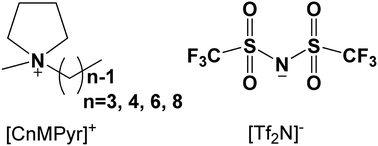The structure and hydrogen-bond properties of N-alkyl-N-methyl-pyrrolidinium bis(trifluoromethylsulfonyl)imide and DMSO mixtures†
Abstract
Mixing ionic liquids (ILs) with molecular solvents can extend the practical applications of ILs and overcome the drawbacks of neat ILs. Knowledge on the structure and hydrogen-bond interaction properties of IL-molecular solvent mixtures is essential for chemical applications. In this work, the structure and hydrogen-bond features of N-alkyl-N-methyl-pyrrolidinium bis(trifluoromethylsulfonyl)imide ([CnMPyr][Tf2N], n = 3, 4, 6 and 8) and DMSO mixtures were studied using Fourier transform infrared spectroscopy (FTIR) and density functional theory (DFT) calculations. Excess infrared absorption spectroscopy and two-dimensional correlation spectroscopy (2D-COS) were employed to extract structural information on the mixtures from the C–D systematic stretching vibrational (νs(C–D)) region of the methyl groups in DMSO-d6. It was found that the mixing process of [CnMPyr][Tf2N] and DMSO is non-ideal and interaction complexes form between [CnMPyr][Tf2N] and DMSO-d6. They are ion cluster-DMSO-d6 complexes and ion pair-DMSO-d6 complexes. In the mixing processes, the species present in pure DMSO gradually decrease from DMSO dimer to DMSO monomer with an increase in ILs. Besides, the ion cluster-DMSO complexes gradually increase, while the ion pair-DMSO complexes decrease due to the strong electrostatic interaction between the cation and anion. In the ion cluster-DMSO complexes and ion pair-DMSO complexes, the ring hydrogen atoms of the methylene group directly attached to the nitrogen atom are the preferred interaction sites of the [CnMPyr]+ cations. All the hydrogen bonds in the identified complexes are closed-shell, electrostatically dominant and weak.

- This article is part of the themed collection: 2020 PCCP HOT Articles


 Please wait while we load your content...
Please wait while we load your content...